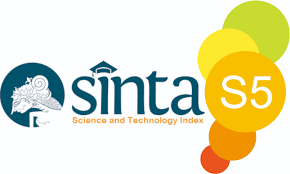Gamification Implementation in Health Service Website in 5.0 Society Era
DOI:
https://doi.org/10.34010/injuratech.v1i2.6777Keywords:
Gamification, Health Service, Web-BasedAbstract
The purpose of this research is to identify how to implement the gamification concept for health service in the 5.0 Society Era. This research is done in qualitative method with descriptive study approach. The results from this research are the increase in public awareness to maintaining their health with the application of gamification element on the health service website. Gamification in health service website interface means presenting game elements in user mechanisms to increase public participation in the needs of everyday health information. This research is to know how to implement the gamification concept in the public health service website in the 5.0 Society Era. The benefit of this research is to increase health public awareness from the gamification web interface and provide health information.
References
[2] Morschheuser, B., Hassan, L., Werder, K., & Hamari, J. (2018). How to design gamification? A method for engineering gamified software. Information and Software Technology, 95, 219-237.
[3] Buheji, M. (2019). Gamification Techniques to Re-Invent Public Healthcare Services–A Case Study. International Journal of Human Resource Studies, 9(2), 339-351.
[4] Gladden, M. E. (2019). Who will be the members of Society 5.0? Towards an anthropology of technologically posthumanized future societies. Social Sciences, 8(5), 148.
[5] Pereira, A. G., Lima, T. M., & Charrua-Santos, F. (2020). Industry 4.0 and Society 5.0: opportunities and threats. International Journal of Recent Technology and Engineering, 8(5), 3305-3308.
[6] Wallenburg, I., & Bal, R. (2019). The gaming healthcare practitioner: How practices of datafication and gamification reconfigure care. Health informatics journal, 25(3), 549-557.
[7] Lee, C., Lee, K., & Lee, D. (2017). Mobile healthcare applications and gamification for sustained health maintenance. Sustainability, 9(5), 772.
[8] Cheng, V. W. S., Davenport, T., Johnson, D., Vella, K., & Hickie, I. B. (2019). Gamification in apps and technologies for improving mental health and well-being: systematic review. JMIR mental health, 6(6), e13717.
[9] Firdaus, L. H. (2021). Desain Gamifikasi Adaptif Untuk Learning Management System Menggunakan Gaming Achievement Goal. Jurnal Tekno Kompak, 15(2), 112-126.
[10] Almira, W., & Alodia, W. Model Gamifikasi pada Aplikasi Smart City sebagai Solusi Pemerintah untuk Meningkatkan Partisipasi Warga. JUPIIS: Jurnal Pendidikan Ilmu-Ilmu Sosial, 11(2), 418-427.
[11] Veronica, J., Intan Febriani, L., Nurhashiva, C., Ragadhita, R., Nandiyanto, A., & Kurniawan, T. (2021). Practical Computation in the Techno-Economic Analysis of the Production of Magnesium Oxide Nanoparticles using Sol-gel Method. International Journal of Informatics, Information System and Computer Engineering (INJIISCOM), 2(2), 1-12.
[12] Hermawan, Y., Warlina, L., & Mohd, M. (2021). GIS-based urban village regional fire risk assessment and mapping. International Journal of Informatics, Information System and Computer Engineering (INJIISCOM), 2(2), 31-43
[13] Br Ginting, S., Maulana, H., Priatna, R., Fauzzan, D., & Setiawan, D. (2021). Crowd Detection Using YOLOv3-Tiny Method and Viola-Jones Algorithm at Mall. International Journal of Informatics, Information System and Computer Engineering (INJIISCOM), 2(2), 13-22.
[14] Kanai, H., & Kumazawa, A. (2021). An Information Sharing System for Multi-Professional Collaboration in the community-based integrated healthcare system. International Journal of Informatics, Information System and Computer Engineering (INJIISCOM), 2(1), 1-14.
[15] Malik, S., Singh, S., Singh, N., & Panwar, N. (2021). Diagnosis of COVID-19 Using Chest X-ray. International Journal of Informatics, Information System and Computer Engineering (INJIISCOM), 2(1), 55-64.












